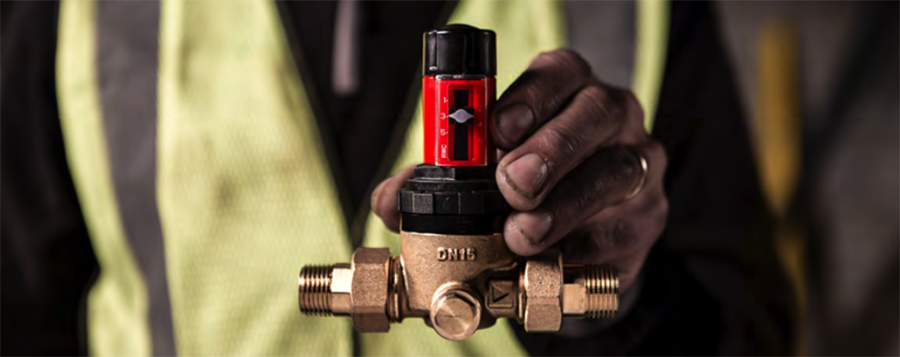Pressure Reducing Valve
A pressure reducing valve (PRV) functions, as the name suggests, by reducing a high inlet pressure at the inlet to a safer, lower water pressure at the outlet. The benefits of PRVs are multiple, as lower water pressures can decrease the amount of damage to heating systems, appliances, and buildings. Considering water pressure in the UK can vary from 1 bar to 20 bar, it is important that any risk to plumbing and heating systems is minimised to keep buildings and people safe.
As there are no regulations on water pressure in the UK there are no regulations for specifying PRVs, however, to reduce risk of unsafe water pressure it is highly recommended to specify them not only for domestic buildings, but especially for commercial buildings, where it is not uncommon to have sudden jumps in water pressure. PRVs ensure that the flow rate of water is not only correct for its intended purpose but that there is a safe water pressure that will allow other valves, such as thermostatic mixing valves, to function correctly as well. The individual valve that should be specified will depend heavily on the type of building, the water flow rate, and whether or not it is being used on a hot or cold-water supply.
The above article is an extract of "Do not get your ABCs confused – all you need to know about TMVs, PRVs and the Tenant Valve" published in the AT journal, issue 144, Winter and written by Richard Bateman, Product Marketing Manager, RWC.
--CIAT
[edit] Related articles on Designing Buildings
- A guide to installing thermostatic mixing valves: what, why and how.
- All you need to know about TMVs, PRVs and the Tenant Valve.
- Domestic hot water.
- Mechanical, electrical and plumbing MEP.
- Ofwat.
- Pipework defects, ventilation and airflow rates.
- Pipework.
- Pressure independent control valves.
- Pressure-relief valve.
- Pumps and dewatering equipment.
- Radiator.
- Tap.
- Thermostatic mixing valve.
- Types of valve.
- Types of water.
- Valve.
- Water safety plan WSP
- Water.
Featured articles and news
One of the most impressive Victorian architects. Book review.
RTPI leader to become new CIOB Chief Executive Officer
Dr Victoria Hills MRTPI, FICE to take over after Caroline Gumble’s departure.
Social and affordable housing, a long term plan for delivery
The “Delivering a Decade of Renewal for Social and Affordable Housing” strategy sets out future path.
A change to adoptive architecture
Effects of global weather warming on architectural detailing, material choice and human interaction.
The proposed publicly owned and backed subsidiary of Homes England, to facilitate new homes.
How big is the problem and what can we do to mitigate the effects?
Overheating guidance and tools for building designers
A number of cool guides to help with the heat.
The UK's Modern Industrial Strategy: A 10 year plan
Previous consultation criticism, current key elements and general support with some persisting reservations.
Building Safety Regulator reforms
New roles, new staff and a new fast track service pave the way for a single construction regulator.
Architectural Technologist CPDs and Communications
CIAT CPD… and how you can do it!
Cooling centres and cool spaces
Managing extreme heat in cities by directing the public to places for heat stress relief and water sources.
Winter gardens: A brief history and warm variations
Extending the season with glass in different forms and terms.
Restoring Great Yarmouth's Winter Gardens
Transforming one of the least sustainable constructions imaginable.
Construction Skills Mission Board launch sector drive
Newly formed government and industry collaboration set strategy for recruiting an additional 100,000 construction workers a year.
New Architects Code comes into effect in September 2025
ARB Architects Code of Conduct and Practice available with ongoing consultation regarding guidance.
Welsh Skills Body (Medr) launches ambitious plan
The new skills body brings together funding and regulation of tertiary education and research for the devolved nation.
Paul Gandy FCIOB announced as next CIOB President
Former Tilbury Douglas CEO takes helm.
























